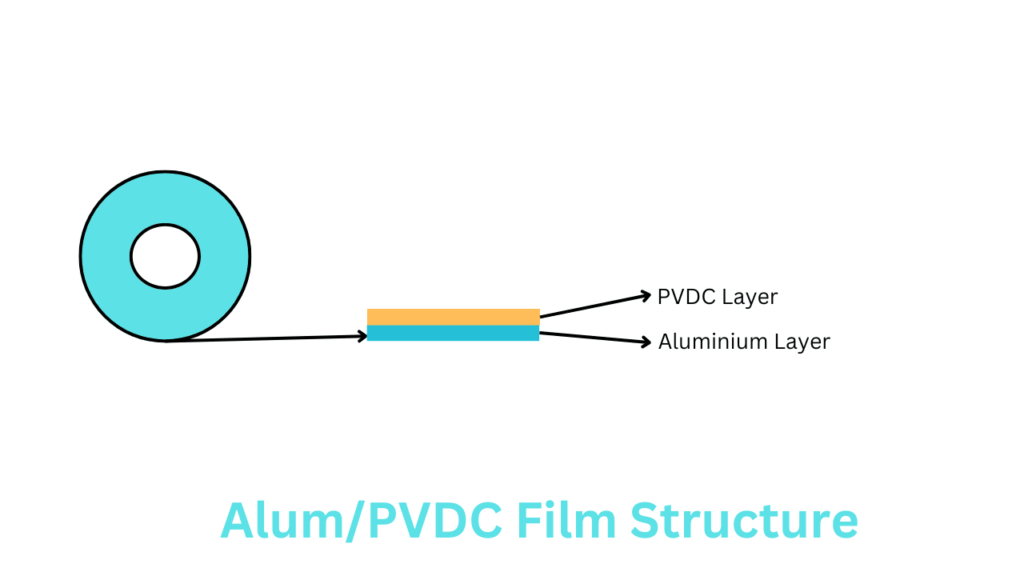
The Alum/PVDC Foil is made from PVDC and aluminum. Itsfoil is made of a thin layer of aluminium laminated with PVDC. The aluminium layer packaging has excellent barrier properties. It protects against moisture, oxygen, light, and other environmental factors. The PVDC layer is PVDC foil, which refers to a plastic film made from polyvinylidene chloride, a polymer known for its superior barrier properties, particularly against moisture and gases like oxygen. It is commonly used in the packaging of food and pharmaceutical products to extend shelf life by preventing the ingress of moisture and oxygen. PVDC is often coated on other packaging materials (like aluminium or plastic) to enhance its performance, making it suitable for sensitive products.
- Description:
The aluminium foil’s thin layer is laminated with a PVDC layer (polyvinylidene chloride). The foil is printed or unprinted foil. There are two types of foil printed on the aluminium side.
2. Text matter:
The sample Alum/PVDC foil is printed text matter that matches with approved shade card or artwork.
3. Color scheme:
The sample Alum/PVDC Foil is printed text matter in many colors, this color scheme matches with a shade card or Pantone card.
4. Width:
The sample of Alum/PVDC foil is measured the total width with the help of measuring scale. They measured the sample and noted it down.
5. Inner core diameter:
The sample Alum/PVDC foil is in a roll that measures the inner core diameter with the help of a measuring scale; the sample measures and notes down the reading.
6.Identification by FTIR:
The sample alum/PVDC foil is for identification testing of the PVDC side. The PVDC layer scan graph with match the reference standard PVDC. The PVDC layer sample is done by identification testing performed with the help of an instrument by FTIR. The sample of the PVDC layer identifies its instrument. Its sample compares the sample of the PVDC Layer reference standard. We take the PVDC Reference Standard and the sample of the PVDC layer side. Its graph is plotted at a wavelength of 3800-650cm-1.
The spectrum obtained from the specimen exhibits major absorption bands only at the same wavelengths as the spectrum of the PVDC reference standard.
7.Grammage:
- Total Grammage:
The selected sample of the Alum/PVDC film testing of total Grammage cut the sample 10 x 10 cm or 5 x 5 cm (if applicable) with the help of a GSM plate. Weighing the sample at analytical balance, calculated the Grammage by the given formula,
Total Grammage= weight in grams x 100 or 400 (if the sample 10 x 10 cm or 5 x 5 cm)
- For Alum and PVDC Layer:
The sample of total Grammage sample dip glass beaker containing acetone, after some time the sample separated both layers. The layer Alum and PVDC dry in the sample hot air oven for 2 min at 700c. Cool the sample, and weigh the sample at the analytical balance. Calculate the Grammage of the alum and PVDC layer by the given formula,
Alum layer Grammage= weight in grams x 100 or 400 (if the sample 10 x 10 cm or 5 x 5 cm)
The PVDC layer Grammage= weight in grams x 100 or 400 (if the sample 10 x 10 cm or 5 x 5 cm)
8. identification of the Aluminium layer by chemical method:
The testing of identification of the aluminium layer by the chemical method by chemical method, take the sample of “aluminium layer Grammage”, weight 15mg of the sample at analytical balance. Take a sample in a glass beaker, add in beaker 30ml 1NHCL then heat on a hot plate. The beaker aluminium foil to dissolve, in solution, add about 0.5 ml conc HCL and thioacetamide regents, no precipitate is formed, add dropwise NaoH solution and a gelatinous white precipitate is formed which dissolves on further addition of 1NaoH Solution after gradually addition ammonium hydroxide solution .gelatinous white precipitate is re-formed.

9. Thickness:
- Total thickness:
The sample selected from the stock, the sample measures the total thickness with the help of a digital micrometer. They measure the total thickness and note the reading.
- For the Aluminium layer:
The sample selected from the “aluminium layer Grammage”, the sample measures the thickness with the help of a digital micrometer. They measure the thickness and note the reading.
- FOR PVDC layer:
The sample selected from the “Grammage of PVDC Layer”, the sample measures the thickness with the help of a digital micrometer. They measure the thickness and note the reading.
10. Pinhole testing of Alum/PVDC foil:
The pinhole testing of the sample of Alum/PVDC foil testing foil of illuminated magnifier tester instrument. When the sample is put on the bench of the pinhole tester. The background light is identified as the hole in the Foil sample. It visually checks the sample is easily identify the any hole and does not have any holes. It test identified the sample has no holes.



